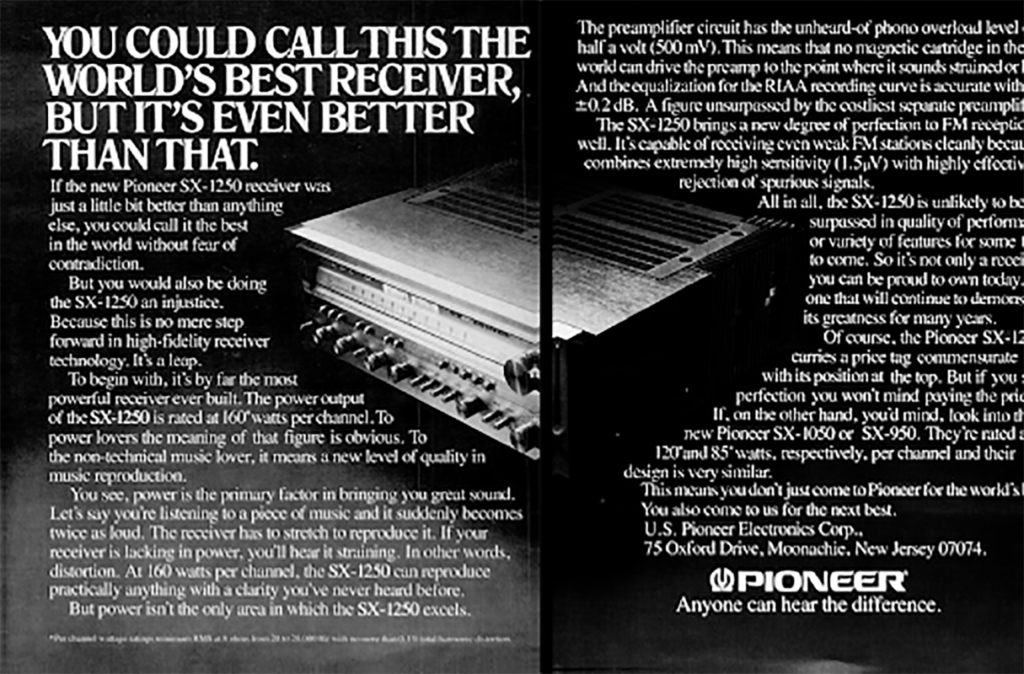Transparent clarity, deep bass, and “Invisible Sound” from German audio company ADS. Background: One of the lesser known hi-fi brands of the ’70s, ADS (Analog and Digital Systems) […]
Classics from the Golden Age of Stereo Equipment: 70’s Pioneer SX Receivers

Surprisingly affordable, powerful integrated receivers with warm, clear sound.
Background:
Maybe it’s the nostalgia. Perhaps it’s the distinctive stainless steel look, with its warm golden glow emanating from the lights within the interior chassis. For some, it could be the entry level price point that is so alluring about these beautiful sound machines. But for this writer, it’s all of the above, and we haven’t even begun to talk about how these things sound.
Built and engineered like refined tanks in the golden age of stereophonic equipment in the mid 70’s, Pioneer was regarded as the high water mark for both value and high fidelity performance. If Apple designed a stereo receiver, anything from the Pioneer SX Series in the 70’s would be it!

Size/Construction:
Known for their elegance and tactility, the build quality and all materials, internal structure, and wood cabinet are topnotch. The dials and switches are beautifully machined and of an extraordinarily high quality. Not only is this a receiver that makes a statement in your listening room but it’s a machine that you feel like you want to interact with.
The minimal design of these complex music conduits make operating the loudness, bass and treble and tone controls a pure pleasure. The smooth resistance of the tuning wheel and volume knob spin so effortlessly and with such a solid feeling, that they add extra authority to the user experience, making you feel as though you are practically engineering the music yourself.
The Pioneer industrial designers even compensated for the visual weight of the large tuner control dial by purposely placing the tuner signal and tuning meters off-center. A less thoughtful industrial designer would have placed the meters dead center, eliminating the complexity of the industrial design, but making it less engaging. All of the controls with these vintage Pioneer SX units have that uniquely satisfying firm push button feeling when engaged, and audible “thunk” when activated.

Sound:
In the 70’s advances in electronic componentry, such as the widespread availability and low cost of reliable silicon transistors, made the design and manufacture of receivers feasible and popular. By combining three components, the power amplifier, preamplifier and tuner onto a single chassis, using a single main power supply and only one cabinet, the integrated amplifier was born.
Pioneer was the pinnacle of this Hi-Fi industrial design in the 70’s, but competition was getting fierce. Newcomers like Kenwood, Marantz, Yamaha, and Sansui gave Pioneer quite a run for their money. At one point there were even “Power Wars” to see who could “out power” who in pure wattage. Pioneer that would be the first company to break the 100WPC (watts per channel) barrier with their SX-1010. From here they would make their lauded SX-1250 model that would put out a whopping 160WPC, and then finally in 1979 they would conquer all with The SX-1980, packing in a massive 270WPC.
The SX-1250 and SX-1980 models are both incredibly powerful integrated amps that sound clear and detailed, but also have that warmth that vintage fans love. They sound great at all volumes and you’ll notice that the sound remains true and transparent throughout. Hook these receivers up to a good pair of large speakers and you can hear the power output in the quality of bass it can put out at high volumes.
Price:
From entry level SX-450 thru to the SX-1250, these magnificent sounding stereo units, with all their charm and character, are surprisingly easy to find on the aftermarket. Whether at an online auction such as Ebay, a reputable online marketplace (Audiogone or US-Audiomart) or even at a thrift-shop, these are pretty easy to find in good condition and at a good price. As I write this story, I am listening to a Neil Young record through a Pioneer SX-550 that I recently acquired on eBay, and I can easily say, it was the best $300 I ever spent.
In Sheep’s Clothing is powered by its patrons. Become a supporter today and get access to exclusive playlists, events, merch, and vinyl via our Patreon page. Thank you for your continued support.










